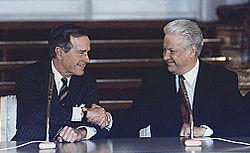| Strategic Arms Reduction Treaty II | |
|---|---|
 Presidents George H. W. Bush and Boris Yeltsin sign START II on 3 January 1993 in Vladimir Hall, The Kremlin in Moscow, Russia | |
| Type | Strategic nuclear disarmament |
| Drafted | 1991 - 17 June 1992 |
| Signed | 3 January 1993 |
| Location | Moscow, Russia |
| Effective | 14 April 2000 |
| Condition | Ratification of both parties |
| Signatories | |
| Parties | (officially withdrew in 2002) |
| Ratifiers | U.S. Senate State Duma |
| Languages | English, Russian |
START II (Strategic Arms Reduction Treaty) was a bilateral treaty between the United States and Russia on the Reduction and Limitation of Strategic Offensive Arms. It was signed by US President George H. W. Bush and Russian President Boris Yeltsin on 3 January 1993,[1] banning the use of multiple independently targetable re-entry vehicles (MIRVs) on intercontinental ballistic missiles (ICBMs). Hence, it is often cited as the De-MIRV-ing Agreement. Despite negotiations, it never entered into effect. It was ratified by the US Senate on 26 January 1996 with a vote of 87–4. Although Russia ratified START II on 14 April 2000, it withdrew from the treaty on 14 June 2002 in response to US withdrawal from the ABM Treaty.
Instead, SORT came into effect, which reduced the strategic warheads count per country to 1,700–2,200.
Impact of MIRV
ICBMs using MIRVs are considered destabilizing because they tend to put a premium on a first strike. Such a missile can carry 3-12 warheads and deliver them to separate targets. If it is used in a first strike, it can thus destroy many of the enemy's missile sites.
Hypothetically, if each side had 100 missiles, with 5 warheads, each, and each side had a 95% chance of neutralizing its opponent's missiles in their silos by firing 2 warheads at each silo, the side that strikes first can reduce the enemy ICBM force from 100 missiles to about 5 by firing 40 missiles with 200 warheads and keeping the remaining 60 missiles in reserve. Thus, the destruction capability is greatly multiplied by MIRVs since the number of enemy silos does not significantly increase.
Both Soviet R-36M and US LGM-118 Peacekeeper missiles could carrying up to 10 MIRVs though the latter are no longer operational.
Negotiations
The historic agreement started on 17 June 1992 with the signing of a joint understanding by both presidents. The official signing of the treaty by the presidents took place on 3 January 1993. It was ratified by the US Senate on 26 January 1996 with a vote of 87–4. However, Russian ratification was stalled in the State Duma for many years. It was postponed a number of times to protest American military actions in Iraq and in Kosovo and to oppose the expansion of NATO in Eastern Europe.
As the years passed, the treaty became less relevant, and both sides started to lose interest in it. For the US, the main issue became the ABM Treaty, which forbade the deployment of a nationwide missile defense system. It withdrew from the ABM Treaty in June 2002, a move that Russia fiercely opposed.
START II did not enter into force. On 14 April 2000, the State Duma finally ratified the treaty, but the move was largely symbolic move since it was made contingent on preserving the ABM Treaty thus the longstanding principle of mutually assured destruction (MAD).
To be specific, Russian ratification was made contingent on the US enate ratifying a September 1997 addendum to START II that included agreed statements on demarcation of strategic amd tactical missile defences. Neither of them occurred because of opposition in the US Senate, where a faction objected to any action supporting the existing ABM Treaty.
Replaced by SORT
However, in 2001, US President George W. Bush set a plan in motion to reduce the country's missile forces from 6,000 to between 1,700 and 2,200.
Thus, the START II treaty was officially bypassed by the Strategic Offensive Reductions Treaty (SORT), which was agreed to by Bush and Russian President Vladimir Putin at their summit meeting in November 2001 and signed at Moscow Summit on 24 May 2002. Both sides agreed to reduce operationally-deployed strategic nuclear warheads to 1,700 from 2,200 by 2012.
On 13 June 2002, the US withdrew from the ABM Treaty, and the following day, Russia announced that it would no longer consider itself to be bound by START II provisions. Both countries continued to pursue their objectives. Russia still retains 54 MIRV-capable RS-20/R-36M (SS-18 Satan) with 10 warheads each, 40 MIRV-capable RS-18/UR-100N (SS-19 Stiletto) with 6 warheads each and 24 MIRV-capable RS-24 Yars with 3 warheads each.[2] The US developed Ground-Based Midcourse Defense (GMD) system to protect itself from small-scale ICBM attack.
In October 2002, the US began its unilateral withdrawal of MIRV (including complete deactivation of Peacekeeper missiles) and completed it by 19 September 2005. The Minuteman III is, as of 2011, the only American land-based operational ICBM. It can potentially carry only three RVs.
See also
References
- ^ "START II". fas.org. Retrieved 19 August 2011.
- ^ "Chapter Five: Russia and Eurasia", The Military Balance 114, Nr. 1 (1. Januar 2014): 180f.